|
|
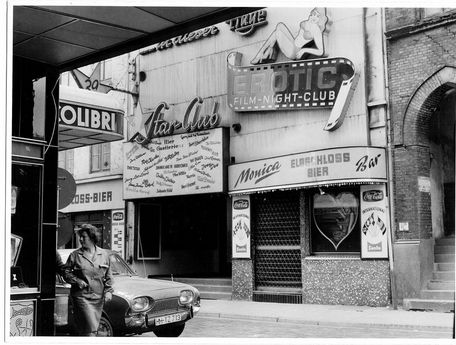
Pre -Ten Years After:
1956 – Alvin
Lee switches from clarinet to guitar after listening to
Charlie Christen. His mother Doris recalls, “he (Alvin)
practiced every minute he could and got on like crazy with
it, so quickly, we knew the talent was there, and nothing
could stop him”.
1957 – Alvin
Lee joins his first band, “Vince Marshall and the Square
Caps”, with Alvin playing rhythm guitar.
1958 – Alvin
Lee is
lead guitarist with “Alan Upton and the Jail-Breakers”.
1960 – Alvin Lee
and Leo Lyons find themselves playing together in the
“Atomites”. Leo joining one
week previous to Alvin. This is with drummer Pete Evens
and recruiting singer Ivan Jay – becoming “Ivan Jay and
the Jaymen”.
1962 – The
“Jaymen” become the “Jaycats” and then the “Jaybirds”.
They spend five weeks playing “The Star Club” in Hamburg,
Germany – just one week after the Beatles played there. Pete Evens is
replaced by Dave Quickmire.
1963 – The
“Jaybirds” return to Nottingham as local heroes and have
new found success in the Nottingham / Mansfield area.
1964 –
Encouraged by their local success, the Jaybirds move to
London, but after “nearly starving to death” they return
home to Nottingham.
1965 –
Ric Lee is the leader and drummer for a band called “The Mansfields”
and as soon as the Jaybirds come to an end, he will be
invited to join Leo and Alvin in their new band.
1966 – The
Jaybirds head for London and work as a backing band to
support “The Ivy
League”.
In November,
they sign up with Chris Wright, with the name “Blues
Trip” – then play one concert at the Marquee using the
name, “Blues Yard”. Then, in a Radio Times Magazine
Listing, Leo Lyons came up with a name for the band that
would in no way tie them down to any one musical style -
"Ten Years After". Ten Years After what is the question?
"Anything we can get" says Alvin Lee in an interview on
Radio Caroline.
1967 -
"Ten Years After" is founded.
|
“I remained a fan
of this guy since I first saw young Alvin, 16 or 17 years old
in his band “The Jaybirds” in the early 1960’s here in
England. This band had a weekly slot at a pub called “The
Cocked Hat” in Aspley, Nottingham. You had to be in the
concert room of this pub by 7:00 or you would lose out – it
would be full, everyone came to hear original R & B played at
it’s very best”.
Derek Smith –
Nottingham, England

 The "Jaycats" 1960
With Ivan Jay
on Vocals - Leo Lyons left on Bass - and Alvin Lee far
right on Guitar


"The Jaycats" 1961
- left to right:
Pete Evans (drums)
- Leo Lyons (bass) - Roy Cooper (guitar) - Alvin
Lee, on his knees (guitar)

(Concert at The Mansfield Palais, 1964)
|

|
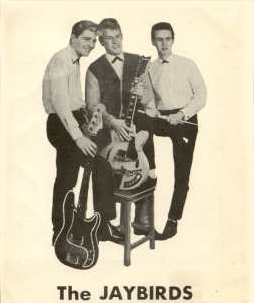 |
|
1962 |
1962 |

To VAL (Taylor)

Alvin Lee 1962

Leo Lyons - Fender bass 1962

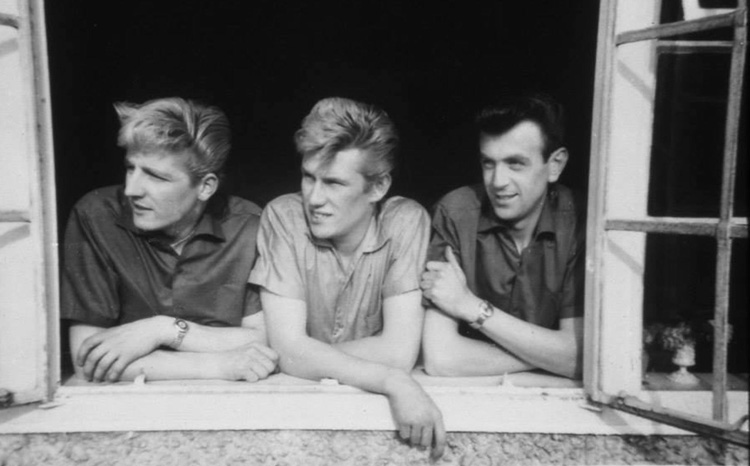

Jaybirds Van
Leo & Pete 1962

The Nottingham Evening Post, 3
February 1962


Nottingham Guardian, 7 February
1962 - Alvin's Tune

Pete Evans 1995 -
Evening Post, 25 February 1995

Nottingham Evening Post, 18 May
1962

The Jaybirds, 1963
1963 November 23 - Jaybirds,
Kirkby-in-Ashfield, Festival Hall
- Advertisement -

|
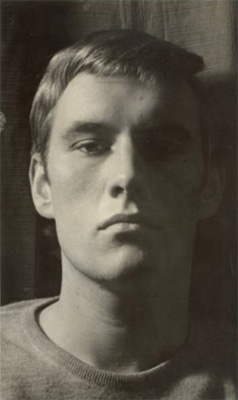
Alvin Lee 1963 |
“The Jaybirds used to play at the YMCA in Nottingham when
Alvin was seventeen or eighteen years old. They played for
years with no recognition.
Then one day, I went to see the movie Woodstock and there
Alvin was. Richard (Rock) Wheatley – second only to you in
early 1960’s Nottingham.
Remember your old school in Bramcote!” |
|
Alvin Lee says,
that when he hears “That’ll Be The Day” by Buddy Holly, it
takes him back to riding on the Waltzer at the Goose Fun
Fair in Nottingham when he was a teenager.
“I remember the diesel fumes from the fairground engines,
the coloured lights and smell of hot dogs and onions…it
all comes flooding back !”

|
|

MIDLAND BEAT
- January, 1964

Alvin Lee in this article is referred to as Alvin Dean
|
|
Question: You were the
entrepreneur in “The Jaycats and The Jaybirds”. Is it true
that you almost starved to death in London?
Leo Lyons:
Our first manager was a business man named Philip Smith of
Mansfield, but things did not work out with him. Not that
it was someone else’s fault specifically, all tried to
perform a series of tasks at the time. We tried to find
another entrepreneur, but in the absence of someone, I
became the manager of the Jaybirds from 1962 until 1967,
when we became Ten Years After and signed a contract with
Chris Wright of Chrysalis Records.
When we moved to
London for the first time in 1961, it was all very
difficult. We shared a single room and all cooked our
dinner in a sort of make-shift stove. We had no money and
it was a real struggle to pay the rent every month. After
some bad experiences, Ivan Jaye and Roy Cooper, who were
the original members of the band, decided to leave because
they were completely disillusioned with the music world.
Alvin and I
stayed, along with drummer Pete Evans and we worked as a
trio until 1966.
Pete left in 1963 and was replaced by drummer Dave
Quickmire. It was around this time in 1965, that Ric Lee
came into the group, and Chick Churchill came a little
later. It was not until our third attempt in London, that
something started working for us. |
|

Young Herb Staehr standing in front of the Star Club - dressed in black

Photo of the late Herb Staehr -
Courtesy of Claudia Staehr
The “Star Club”
Hamburg
The Star Club, was a famous music club located in
Hamburg, Germany. It opened on Friday April 13, 1962 and
was initially operated by Manfred Weisslieder and Horst
Fascher. In the 1960’s, many giants of rock played at
the club. The club closed down on December 31, 1969 and
the building it occupied was destroyed by a fire in
1987.
The club achieved worldwide renown through the famous
performances of the following acts:
The Beatles – The Rolling Stones – Billy J. Kramer –
Black Sabbath (known back then as “Earth”) – Cliff
Bennett and the Rebel Rousers – The Londoners (known in
England as “The Knack”) - Cream – Dave Dee, Dozy, Beaky,
Mick and Tich – The Graduates – The Jaybirds (later
known as Ten Years After) The Remo Four – The Searchers
– Richard Thomson – The Soft Machine….and American
Musicians including: Ray Charles – Bo Diddley – Fats
Domino – The Every Brothers – Jimi Hendrix – Johnny and
the Hurricanes – Brenda Lee - Jerry Lee Lewis and Little
Richard with Billy Preston in his band.
Note: The Jaybirds played there the following week right
after The Beatles successful stay at the club. Leo Lyons
also played with Tony Sheridan while there.

Special Note:
Does anyone remember the bands that played at the
“Wharncliffe”
in the 1960’s?
I personally remember, and got a photo and autographs
from Alvin Lee and the “Jaybirds”, later on they became
“Ten Years After”.
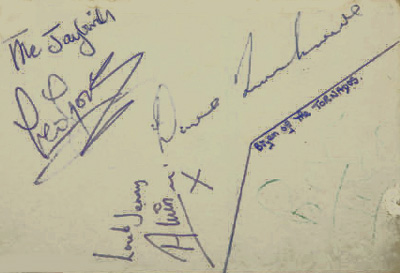
"The Jaybirds" Leo Lyons - Dave Quickmire - Love To Jenny from
Alvin Lee
Bryan of the "Tornadoes" - Brian Gregg

|
The Jaybirds
From A 1966 Article:
When Alvin Lee was a
member of “The Jaybirds” he was breaking new ground when he
was forced to play a lashing, stinging five minute solo
introduction to “Money” (that’s what I want) as chairs and
fists flew dangerously close to the stage. But, in those days
Alvin had quite a reputation as an innovator. Many have still
never recovered from the traumatic effects of the time that he
tottered into the concert hall, with the first pair of Cuban
Heel Boots ever seen in Sutton…but Alvin had a certain polish
even then. The group’s version of “Poison Ivy” was thought by
many to be an improvement on the Rolling Stones EP version and
nobody could change from rhythm to lead guitar with quite the
same smooth panache as Alvin.
The Jaybirds:
There’s a bit of
confusion about The Jaybirds on the Embassy Record Label, but
reliable sources confirm that this was the combo with Alvin
Lee and Leo Lyons. They recorded cover versions of the top
twenty hits for Woolworth’s Cheapo Label.
- Juliet / Here I Go
Again – Embassy WB635 – 1964 British Charts Only
- All Day And All Of
The Night – Embassy WB663
- Good Golly Miss
Molly / A World – Embassy WB626
- Can’t Buy Me Love /
I Love You – Embassy WB625
Juliet was a hit for
“The Four Pennies” – “Until It’s Time For You To Go”
All Day And All Of The
Night – was a great hit for The Kinks, reaching number two on
the charts in 1964
The Jaybirds also
backed The Ivy League – Dave Quickmire photo here.
|
“The Dancing
Slipper Ballroom” also known as “The Nottingham Jazz Club”
Memories by Gregory Dix (Drummer with "The Hoodoos")
“I was in a
Nottingham band called “The Hoodoos” circa 1963 or so. We
opened once for “The Jaybirds” at the old “Dancing Slipper
Ballroom” in West Bridgford. It also went under the name
“The Nottingham Jazz Club”. We played at the end stage and
they were on in the middle. Their stage was barely big
enough for them, and our stage was half the size, and
there were five of us! The place stank of beer and cider,
and there was often violence as the “Teddy Boys” used to
come and pick fights all the time. Very interesting times.
But the Jaybirds were amazing, we all loved them and
Alvin’s playing was something else. He drove a yellow
Bedford Dormobile with a black-bird logo on it. He had a
great looking blonde girlfriend at the time too. Anyway, I
got to see Ten Years After a few times in the past couple
of decades, and he (Alvin) hasn’t lost his magic. Glad to
see the memory of the Jaybirds lives on”.

Regards, Greg
Dix (drummer with "The Hoodoos”)
“The Hoodoo’s ”
are listed there along with “The Jaybirds” and a Who’s –
Who of bands from the day. I recently caught Savoy Brown
in Dallas, Texas and was razzing on Kim Simmons after the
show, about the time I went to see them at “The Boat Club”
– it’s the social room and bar above a university rowing
club-house on the banks of the river Trent.
Everyone played
there and the floor used to feel like it was going to give
way with the amount of people they crammed in. The stage
was tiny, there was no head room but the atmosphere was
brilliant. It’s still going and I hope it can maintain, as
so many have fallen (Like CB-GB’S) taking with them so
much history. They protect some second rate house for it’s
so called historic value, but not a music club that has
been like a “Church” to so many lovers of live music.
“We used to go to
the “Dancing Slipper / Nottingham Jazz Club to catch the
“Jaybirds” whenever they played there, we were maybe 15
years old and too young to buy cider, but we did anyway.
Back then there was no such thing as I.D. checks, and the
barman used to say, “are you 18?” and that was that. The
last time I was back in Nottingham I went by the place
that used to be The Dancing Slipper, it’s now a
restaurant, and of course the old garage that used to be
below, it’s now a store front. The Nottingham Jazz Club,
which was what the Dancing Slipper turned into on Saturday
nights in the early 1960’s used to get amazing acts.
In fact, my band
“The Hoodoo’s” opened for visiting headliners a few times.
Including for “Long John Baldry” and the “Hoochie Coochie
Men” once, and that was when Rod Stewart was his lead
singer.
There was a fish
and chip shop across the road and on cold foggy nights
there was nothing like standing outside with a bag of
piping hot chips before riding home on our bikes.
Yes, the Jays
(Jaybirds) were certainly a class act, even when they were
probably all only 17 or 18 years
old. We knew they would be big someday”!

Regards, Greg Dix - (Drummer with “The Hoodoo’s”)
The Dancing
Slipper – is located in West Bridgford which is a suburb
of Nottingham
(which
incidentally is where I grew up) and while I couldn’t find
any images of the interior during it’s hay-day, there were
a couple of recent photos of its exterior, so that you can
get the general idea of the place.
The room was above
what are now shops, but it was a car repair garage back
then. There wasn’t a stage door and everyone went in and
up the stairs, (those double white doors that say “West
End” on it now). So dragging amps, drums etc. up stairs is
never fun, but I remember one Saturday when we (The
Hoodoo’s) opened for The John Mayall Band, I think it was,
or maybe it was Georgie Fame, I can’t remember exactly,
but I do know that it was a headliner from London, so it
was a very big deal. We helped them lift the Hammond B3
in, if you’ve ever lifted a Hammond B3, you’ll know why it
takes ten gorillas to haul it up a full flight of stairs.
It’s amazing that bands still use them (the B3 that is,
not the stairs) in live shows, even though there are
“synthesised modules” that will make almost the same
sound.
My band “The
Hoodoo’s” did three or maybe four gigs here at the
“Dancing Slipper / Nottingham Jazz Club” – As I have
mentioned previously, The Hoodoo’s opened the show for
“The Jaybirds” but
I think the three of them, being Alvin Lee, Leo Lyons, and
not Ric Lee in 1962, but with another drummer, Pete Evens
(Greg wasn’t exactly sure of the line up - Dave) and they
definitely didn’t have keyboards at that time. A couple of
gigs at the “Boat” located at the University “Boat House”,
on the river under the Nottingham Forest grand stand and
one I think at “The Rainbow Rooms” in the city. Other
venues too, local pubs etc. but I can’t recall the names
at the moment. We did a bunch of gigs at “The West Bridgford Parochial Hall”
(The Church Hall)
and we had two “Guards” who were both “Teds” (Teddy Boys)
who stood at the front of the stage and kept trouble at
bay. They were both hard lads, but for some reason felt an
affinity to our silly band, and as we were decent to them,
they took it on themselves to be our de-facto body guards
and this was long before bands had such a thing – I’m
laughing to myself, just recalling those times so long
ago. Our guitarist had to hit people a fair bit, so his
brand new white Stratocaster guitar had quite a few dings
and dents in it. I’m sure that every band from that era
had to defend themselves, at every gig, so it was just
standard operating procedure back then. England in the
early 1960’s was pretty violent, but no guns!
Anyway, one night
I did my usual party piece at the end of the drum solo,
(Yes, back then drummers did stupid, really naff (lame)
drum solos, it was kind of expected, just ask Ric Lee
about it, and I’ll bet he hated them too) although I
really hated doing one and ended with a flourish by
grabbing the crash cymbal stand and pulling the cymbal to
the stationary stick.
(usually you hit
the cymbal with the stick, and not the other way around) –
I was told it was visually exciting. The long and short of
it was that, as I basically threw the cymbal and stand
back into its place after the finale crash, the cymbal
came off (probably due to the excessive beating it had
been taking, and yes, Buddy Holly and Chuck Berry covers
could do that, laughing my ass off just thinking about it)
and it flew out into the crowd, well the twenty or thirty
attendees who were there, just feet from my drum kit. My
precious 18” crash cymbal basically decapitated this one
poor bloke, who fortunately was drunk, despite there being
no bar at the Church Hall (Wollaton) and perhaps he
didn’t feel very much. There was a lot of blood, screaming
and jostling but our two guys maintained peace and I
didn’t get into a fight, which was good, although at age
16 and a rugby player, I was pretty fit and could fight
OK, as we had to do quite often back then. Today of
course, the venue and band would all be sued for millions
and I would have been beaten up no doubt by the wounded
chaps friends. It was extremely violent and very rough
back in the early 1960’s. The “Teds” were the main problem
and anyone who wasn’t a Ted pretty much feared them. Many
were coal miners, so you can imagine their fighting
ability was fierce and unrelenting. Many carried knives
and one “Ted” leader who frequented our gigs, for some
reason (maybe because we played a lot of Buddy Holly stuff
– and Buddy was idolised by the Ted’s – they took him as
their own) he is rumoured to have killed more than one
person. Looking back, our little band, (actually their
were five of us) so logistically it was awkward) could
have been at the right place at just the right time, and
we might have made the big time had we all stuck with it,
but my mother was consistently nagging me to finish my
schooling and stupidly, I respected her wishes and
resented her for this for the rest of her life. Ah Well !
Yep, I can
definitely imagine Alvin’s ego going across the red line
zone on occasion, and that he was a pretty high
maintenance person. Leo on the other hand always seemed
like a big teddy bear in comparison to the very
high-strung Alvin. As I do recall one of the guys in our
band, when we were opening for the “Jaybirds at the
Dancing Slipper” saying, what an arrogant person Alvin
is. I mean, Alvin did have a rock-star persona, even back
in 1962.
He even went so
far as to legally change his given birth name of Graham
Barnes (which to him was not memorable enough) to Alvin
Lee. Even driving around in the bands van, he definitely
had an unbecoming arrogance about him that rubbed people
the wrong way.
There are so many
bands that have toxic scenes when the ego’s and creative
powers clash.
Or the members are
not synchronised, but that same unwanted constant friction
in turn, sometime becomes a powerful creative force. A
grain of sand, irritates the oyster and the oyster creates
the pearl !

Greg Dix and Pete Best - after Pete's show in Dallas,
August 2008 |
|

MIDLAND BEAT - August 1965
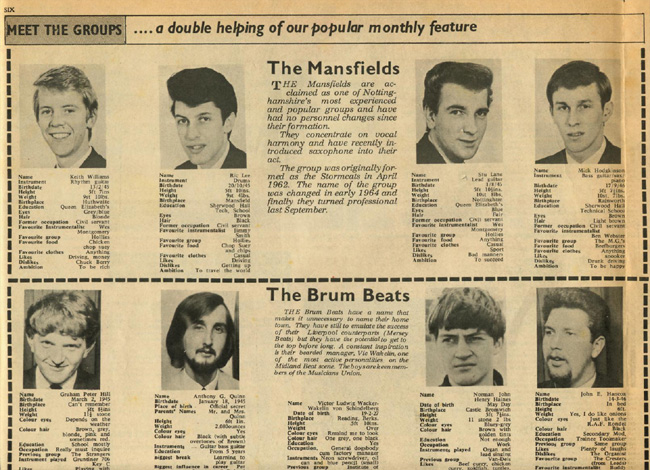

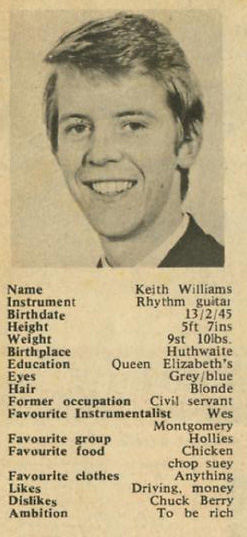




|

Ricky Storm and The Storm Cats - 1965
Ric Lee and the Original "Storm Cats" - Who
Later Became "The Mansfields" - Ric Lee went
on to become one of the original members of TEN YEARS
AFTER
In the above photo are: Ric Lee, Mick Hodgkinson, Keith
Williams and Stuart Lane
|
Ric Lee
began playing drums and percussion instruments at school,
and joined two other classmates to form a three piece band
called “The Falcons”. After only a short amount of time,
with The Falcons, Ric was asked to join a very promising
local band called “Ricky Storm and the Stormcats”. This
band then transmogrified into “The Mansfields”.
The Mansfields
consisted of: Stuart Lane on Guitar, Mick Hodgkinson on
bass guitar, Keith Williams on
vocals, and Ric Lee on drums. After this outfit, Ric met
and studied with drummer Dave Quickmire who had one of the
hottest bands in the Nottingham area, called “The
Jaybirds”. The bands guitarist was Alvin Lee, the bassist
was Leo Lyons. Dave left the Jaybirds in August of 1965 to
get married, he then insisted that Ric audition for his
position in the band. That same month, Ric was hired to
take over the drumming duties. The Jaybirds line-up of
Alvin Lee, Leo Lyons, and Ric Lee was formed. They began
performing all over the East Midlands and North of
England, billed as “The Biggest Sounding Trio in the
Country”, and backed it up by playing hard, guitar based
rhythm and blues.
The Finishing
Touch:
The band was now
convinced of their ability and potential. In the Spring of
1967, “The Jaybirds” –
decided it was time to contact Chris Wright who was
becoming well known as an agent and manager in the North
of England. Says Alvin Lee: “ We were getting a free meal
and twenty four quid a week, which was good money, but the
only gigs we were getting were in Wales and they were
terrible. Although we could still get the backing jobs and
do the odd session, everybody was very downhearted indeed.
Says Chris Wright:
“Leo Lyons, bass player and organizer for a London-based
blues band called “The Jaybirds”, called and asked for a
weekend of work in the North. They were really good and
asked me to manage them straight away. I wanted to, but I
thought it would be tough getting work over the summer.
They still had the odd gig backing “The Ivy League” and
“The Flower Pot Men”, but I managed to start getting
them dates in their own rite.
The band went down
well wherever it played and dates at some of London’s
famous clubs were coming our way”. It was right after
Chris Wright signed on the “Jaybirds” that they added
keyboard player Chick Churchill to broaden the bands
sound. According to Leo Lyons, “Chick’s jazz
influenced – blues- rock – playing added a strong rhythmic
and harmonic foundation to the band”.
The Name:
With their brand
new four piece line-up, “The Jaybirds” became “The
Jaybird” dropping off the “S” to be a bit more trendy.
Then we changed to “The Blues Trip” and then “Bluesyard”.
Leo Lyons got the
band an audition and their first gig at London’s legendary
“Marquee Club”.
Says Alvin Lee:
“Of all the clubs in London, in those days, the Marquee
was the most important. We managed to build a small
following among the blues freaks and got a residency. I
was quite in awe of that place, I remember going to see
groups there before we started, people like Peter Green
and John Mayall.
It was following
their Marquee Club debut that the band decided that their
current name placed a limitation on their music, so after
that one gig as “The Bluesyard” they selected the new name
of Ten Years After. It had other connotations, because our
music was a cross between “Muddy Waters” – “Chuck Berry”
and “Elvis Presley”.
Leo Lyons chose
this name out of “The Radio Times Magazine”.
That is all the
basics that you need to know. Now you’re ready. You have
the band members in place, the name in order and now you
just follow the bands history. |
| Notes
Chick Churchill joined a band called
“The Sons of Adam” The band was from Nottingham and they
played at the California Ballroom on May 8, 1965 – says
drummer Mick Franks.
The Members
Include: Paddy Flynn – Vocal / Lead Guitar – Roger Lymn –
Vocals / Guitar – Harry Hopewell – Vocals / Bass Guitar –
Mick Franks – Vocals / Drums – Troy Wayne – Lead Vocals
The Band “Killing
Floor”
Edward booked the
band for Dunstable’s California Ballroom and so gave
Killing Floor support slots to the likes of Ten Years
After, Jethro Tull, Chicken Shack, The Heard, The Casuals and
Junior Walker and the All-Stars.
|
| Notes ...
“The
Jaybirds, Nottingham, The Dancing
Slipper, Elizabethan Rooms, Sherwood Rooms, they were
great times! The van we had was a “Commer” and the bird
painted on the side was supposed to be a Jaybird”.
Leo Lyons
A fan writes,
“The Sherwood Rooms in Nottingham have now been converted
to a big Disco club called “Oceanic”.
“Alvin
Lee was from Sutton Passeys Crescent Wallaton. Chick
Churchill was from Beeston where his folks had a sweets
shop”.
“I used to see
“The Jaybirds” regularly at the Gaumont on Saturday
mornings. On the corner of Wollaton and Goldsmith
street”.
The
YMCA – Venue was on Arkwright – and the “Rainbow Rooms”
were at the bottom of Broad Street.
Does anybody
remember the YM opposite the fire station on Goldsmith
street? I saw Alvin Lee with The Jaybirds there one night.
(1964 ?) No booze, but a fight broke out anyway!
Alvin
Lee, as I remember it, was with the Jaybirds? Though he
was part of another band earlier, maybe called The Jaycats?
I do know later (less Alvin) that band supported Herman’s
Hermits.
|


TYA Family Tree
1957 - 1975
created by Steve, from Nottingham
| Please find below, the
deciphered text from the article above:
FAMILY
TWIG – BY PETE FRAME - who founded "Zig-Zag"
magazine.
FROM
- FEBRUARY OF 1967
“THE
IVY LEAGUE” AND THE “JAYBIRDS”
In
the summer of 1964, song writers John Carter and Ken
Lewis Co-Opted Perry Ford to form a trio specialising in
vocal backings – “Can’t Explain” by the WHO
(November 1964) was
their finest, from a Mojo viewpoint. Soon they
started cutting singles as the “Ivy League” (1964)
and when the second, “Funny How Love Can
Be”, went top ten, they formed a backing band,
and began touring.
In
January of 1966, John Carter dropped out as did the
backing band. Enter Tony Burrows (ex Kestrels ) and
Nottingham group “The Jay-Birds” (by far the best
bunch to audition) and this line-up continued until
February of 1967. During their year together, their best
single was the Carter / Geoff song “My World Fell
Down”, in which Gary Usher and Sagittarius turned into
a masterpiece. In the meantime, Carter went on to make a
fortune as lead vocalist on the multi-million seller –
“Winchester Cathedral”. He and Lewis would soon
re-unite as the –
“Flower
Pot Men” (whose line-up also included Burrows!) in the
foliage of the most incestuous and complicated family
tree ever attempted by your humble genealogist…. And
as for those “Jay-Birds”, they re-styled and were
re-launched as “Ten Years After”.
Alvin
Lee – Guitar – Leo Lyons – Bass – Ric Lee –
Drums – Chick Churchill – Keyboards.
|
More
About:
Tony
Burrows
Edison Lighthouse - “Love Grows
Where My Rosemary Goes” (1970)
Pipkins
– “Gimme Dat Ding” (Sung by Tony Burrows –
1970)
White Plains – “My Baby Loves Lovin´”
(June of 1970)
The Brotherhood Of Man – “United We Stand”
(1970)
Flying Machine – “Smile A Little Smile For Me
Rosemarie” (1969 went to number five in the US)
Ivy
League:
Tony
Burrows – Vocal
Ken Lewis – Vocal
Perry Ford – Vocal
Neil Landon - Vocal
They
were mainly popular in the 1960’s – Carter’s
craftsmanship can be heard at work on the
following songs:
- Carter
Lewis and the Southerners
- The
Ivy League – “Funny How Love Can Be”
(1965 reached number 8)
– “That’s Why I’m Crying”
(1965 reached number 22) – Willow Tree (1966
reached number 50) and “Tossing and Turning”
(reached number three in the top ten charts).
- Herman’s
Hermits – “Can’t You Hear My Heart
Beat” 1965 – Which went to number one in
the UK and number two in the USA.
- Brenda
Lee – “Is It True” (Became a gold record
in 1964)

- The
Music Explosion “Little Bit O´ Soul” (From
the Ohio Band – 1967 – the song peaked at
number two on the US charts)
- Peter
and Gordon – “Sunday For Tea” (1967)
- The
Flower Pot Men – “Let’s Go To San
Francisco” (1967) (Neil Landon and Tony
Burrows)
- First
Class – “Beach Baby” (1974 and made it
into the US top five – sung by Tony Burrows)
- Mary
Hopkin – “Knock- Knock Who’s There” (Released
March 23, 1970 on Apple Records)
- Kincade
– “Dreams Are Ten A Penny” (Released in
1972) Germany
Neil
joined “Folkestone” group the “Brunettes”
(1962-1965)
Neil
Landon was invited to join “The Ivy League” By
Carter, Lewis and Perry.
He
was born Patrick Cahill on July 26, 1941 in
Kirdford, Sussex, England. A singer who has been
credited with singing on a number of hits in the
UK singles chart. In addition, he is notable as
being the lead singer and a principle songwriter
with the band “Fat Mattress” which he
co-founded with Noel Redding, bassist of the Jimi
Hendrix Experience. Fat Mattress recorded two
albums and were working on a third, but due to
lack of commercial success, they decided to
disband at the end of 1970. Their highlight came
when playing The Isle Of Wight Festival 1969.
In
1974 Neil relocated to Hamburg, Germany.
In
2001, Landon’s solo show, “Musical
Highlights” was a big success with audiences,
and in the summer of that year, he appeared with
his own new “Neil Landon Band”.
As
an aside: I got to meet Neil Landon at the Hamburg
Blues Festival. He was having an intense chat with
Leo Lyons. From the body language, they were
reminiscing about old days and catching up on new
things. It was the type of conversation where a
fan like me, keeps his distance so as not to
interfere until their finished. After they parted
I asked Leo who he was talking with – Neil
Landon he replied, it didn’t ring a bell and it
must have shown on my face, where by Leo helped by
saying that Neil was in the “Ivy League”.
Later on I crossed paths with Neil and introduced
myself, shook his hand and nothing more. I know
more about him now then I did back then. He
didn’t know me at all. The next time it’ll be
very different, and I’m looking forward to it.
|
|
|
About
Alvin Lee:
“I
used to know Alvin and Leo Lyons, from The Outer Limits
days when we used to go see them at The Cro-Magnon in
Leeds, England, when they were part of “The Jaybirds”.
They were a great Blues and Rock three-piece, mid
1960’s band and we had lots of laughs with them.
“There were two London brothers, called Cyril and
Arnold Entin who had this coffee bar called the
“Cyrano” and after moving around the corner in the
early 1960’s – it evolved into the “Cro-Magnon”.
Which became a great club for groups from all over the
country.
“We
played there often, as did the “Jaybirds” from
Nottingham, and a kind if friendship developed between
the two bands: We used to have water-pistol fights in
the club, after all the punters had gone home, around
two or three in the morning – with Arnold and Leo.
They both had a limp and ended up getting soaked because
they couldn’t run as fast as everyone else.
“Strangely
enough, I never ever came across Alvin Lee, Leo Lyons or
Chick Churchill once they or I became widely successful”.
Cyril had a heart attack and died in 1990, and a benefit
gig for him took place at a venue in Leeds. The Outer
Limits reformed for that gig, as a one-off and it helped
kick-start my own restart of “Christie Mark Two”,
with the first gigs later that year”.
Note:
Christie and Ten Years After did appear on the same
concert bill at least once.
Hank
Marvin, lives only ten minutes away from (this webmaster)
of the “Shadows” and Alvin Lee of Ten Years After.
Jeff
Christie – Lead Guitar – Keyboards and Vocals
Clem
Cattini – Drummer with “The Tornados”
Hugh
Grundy – from “The Zombies”
|
|
The Very Early “Marquee
Club” Years:
“I mean, the
Marquee was bleeding square, with a capital S”. The only
people who went there were beatniks looking for a bit of
jazz, and really out-of-touch geezers who couldn’t tell
the difference between a Vespa GS and a Harley Davidson. The bands that played there, apart
from a very small exception, were completely off the wall.
and a Harley Davidson. The bands that played there, apart
from a very small exception, were completely off the wall.
From Irish Jack –
The original Mod from the Goldhawk Social Club.
At the end of the
Marquee’s 1963 news letter, John Gee, the club’s
secretary, closed with this premonition line: “Massive
Swing To The Blues”.
Roll Over Beatniks, Poetry and Jazz:
The last night
at the Oxford Street Marquee Club, on Sunday March 5,
1964 featured the Jazz Saxophonist Stan Getz, along with
a new rhythm and blues band that was revolutionizing the
London music scene. They had started a Thursday night
residency at the Marquee about a month before, and they
were called, “The Yardbirds”. The band featured the
ultimate sensation on the London music scene, the
guitarist was Eric Clapton.
The original
Marquee Club, located at 165 Oxford Street was
regrettably demolished.
On Friday March
13, 1964 the venue was relocated to its most famous
location in London’s Soho district at 90 Wardour Street,
to become a legend in the history of pop and rock music.
The new Marquee Club, was a replica of the old one,
including Angus McBean’s Circus decorations and large
mirror panels were placed all around the main room, in
order to provide a feeling of space.


New
Music – New Problem - Noise:
“We had done
such a great impersonation of the original location that
people thought they were in the same building. The main
problem now was the noise. When playing jazz, the sound
doesn’t carry very far, or bother anyone outside the
venue. But when you amplify equipment, starting with 30
watts, then 50 watts, 100 and 1,000 – you need a lot of
heavy duty soundproofing, which in this case means
losing some stage space”, says Harold Pendleton.
John Gee:
John Gee, was
the club’s secretary from 1968 until 1970. He describes
the opening night at 90 Wardour Street, New Marquee
location in a newsletter that was published in the
“Jazzbeat” magazine newsletter: “Thanks to the valiant
efforts of builders, electricians, caterers and 101
other sundry characters, the New Marquee Club opened
dead on time at 7:30 pm, on Friday March 13, 1964. By
that time, an absolutely fantastic queue had assembled
and most regretfully we had to turn some 600 patrons
away from the door, this after the “Full House” notice
went up. Sonny Boy Williamson really made Wardour Street
wail that night, and took his farewell bow in a
magnificent fireman’s helmet, that was presented to him
by Mr. Coombs, our club manager, who held that position
until his retirement, Chief Fire Officer of Richmond. In
April we hope to have the main club area completely
finished”.
Long Live Rock – The Destructive Side:
It was during
the last few months of 1964, that “The Who” started
their long residency at the Marquee, bringing with them
the winds of musical change and attitude, that were just
starting to invade the British - London scene. The “Who”
presented their powerful / explosive brand of Rock `n ´
Soul music that spearheaded the 1960’s music front for
the “Mods” in London.
During those
days, the band had just started becoming famous and
notorious for its legendary smashing their equipment
during their on stage performance. “My most memorable
moment at the Marquee, was when Pete Townshend started
smashing up his guitar. Really, you should have seen the
audience, mouths open, great rows of teeth showing, you
could almost count the cavities”… says Keith Moon, in
Beat Instrumental magazine, June 1968.
Before They Were A Progressive Band:
During this same
time period, a promising new band arrived on the scene.
Their name, “The Moody Blues”. Within one year, they had
a number one hit single in the Melody Maker Charts –
called “Go Now”– which was also recorded at the Marquee
Studios.
The Moody Blues
also began their long residency at the club.
More New Blood:
In 1965, two
future legends in the history of pop music got their
start at the Marquee.
David Bowie and
Spencer Davis Group featuring Steve Winwood.
|
|
LEO LYONS - TODAY - 1967-2010 - 43 Years Later and Still
Leading TYA Into The Future!

|
In
an interview with Leo Lyons, founder and leader of “Ten Years After” for the last 43 years, comes the most
frequently asked question about the band. Where
did the name Ten Years After come from?
Leo
Lyons - Answers This Question:
I
was looking through a newspaper that advertised
radio programs
it was called “Radio Times”, there was
an advertisement for a book…called Suez…you
know, the Suez Canal? And the book was called
“Suez Ten Years After”. We were looking for a
name (For
The Band) and I thought, well, Ten Years After
would be very interesting, because for the next
forty years, people are going to be asking me,
where did the name for the band come from?
It’s an interesting name, in as much as
the number ten is an interesting number, alpha and
omega, the beginning and the end, and it’s an
important number in the Tarot…yes there’s a
lot of things you could say about it, and over the
years I guess I have!
|
|
| From Alvin Lee:
“Ivan Jay, and The
Jay-cats”. “Ivan is living in San Diego, California now.
He’s a car racer and one of my heroes. He was a bit older
than us, and we all looked up to him. He had bright blond
hair and my mum (a hair-dresser) dyed his hair pink and
blue on the sides, and he had to go home on the 39 bus”.
“The Dancing Slipper” – “The Carousel” – “The Cocked Hat
and “The Regal – that was located in Ripley. Alvin’s first
official gig was with the “Jailbreakers”. He then formed
a band with singer Ivan Jaye Harrison they called the
“Jaycats” says Alvin Lee, “we did a rock ´n` roll set
together. Those were my formative years”. |

Ivan
Jay Harrison
| IVAN JAYE –
Pre Ten Years After:
“ Ivan was a few
years older than me and I really looked up to him. As my
old friend says, he had his hair bleached white blonde.
One time he decided he wanted it blue on top and pink on
the sides, which my mom (the hairdresser) did for him. He
went home on the bus and got some very strange looks. This
was 1960”.
“I was hanging
around with Ivan when I discovered sex and rock `n´ roll
(no drugs in those days). He used to have girls chasing
him down the street and I was impressed”.
“The Jaycats was
one of my favourite periods. We started as “Ivan Jay and
The Jay Men”, and moved to the
“Jaycats” which was a great name. Later it became “The
Jaybirds” but that was after Ivan”.
“Ivan had this
dodgy old car, a Wolsey I think (they were built like army
tanks).
He’d just bought it and even in those days he was a good
driver and he liked to race around Nottingham. On this one
particular occasion we were driving down Arkwright street
and Ivan said, “I’m going to test the brakes” he slammed
them on and only the front right was working which caused
the car to swerve violently across the on coming traffic
and straight through some gates on the other side of the
road. As the car skidded to a halt, amid the dust, I
looked up and saw a sign in front of us, it read – “J.
Pownell Scrap Metal Merchant”. Ivan looked across and
said, “Looks like we’ve come to the right place”.
Alvin Lee |
| Ivan was born and raised in
Nottingham, then moved to 9112 North Cote Road, Santee
California where he and his wife lived for 28 years. He
drove stock cars under the NASCAR banner for 20 years at
the Cajon Motor Speedway. He drove a 2000 Ford on the
track, stock car circuit. Congratulations go out to Ivan
and Rosemary Harrison, whose racing team just completed 17
years of 100% participation in racing. To tie Mark Norris
for the record, for most consecutive years of showing up
to compete every single race night. In the end,
The Cajon Speedway property at Gillespie Field, El Cajon -
was reverted back to San Diego County.
In his youth, Ivan was the lead singer for “Ivan and the
Jay-cats” from 1960 to 1962, with Leo Lyons on bass
guitar, Alvin Lee on lead guitar, Pete Evens on drums and
----on rhythm guitar. During his time in the “Jay-Cats” he
performed well over two thousand concerts throughout
Europe.
Notice of his passing, from "The
Coronado Playhouse" to the memory of Ivan J. Harrison.
This show (The Spiders Web) is dedicated to the memory of
Ivan Jay Harrison, who was a beloved friend, board member,
actor and technician at the Coronado Playhouse, who
recently died of cancer. This announcement was from April
17, 2009 |
|